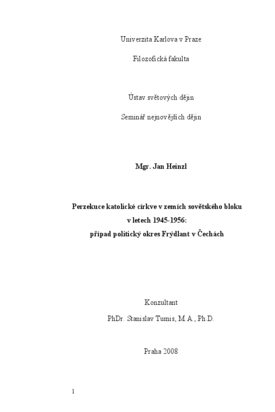Perzekuce katolické církve v zemích sovětského bloku v letech 1945-1956: případ politický okres Frýdlant v Čechách
Persecution of catholic church in former soviet countries in the years 1945-1956. Case: political process in Frydlant in Bohemia
rigorózní práce (OBHÁJENO)

Zobrazit/
Trvalý odkaz
http://hdl.handle.net/20.500.11956/21207Identifikátory
SIS: 71332
Kolekce
- Kvalifikační práce [23212]
Autor
Vedoucí práce
Oponent práce
Kovář, Martin
Fakulta / součást
Filozofická fakulta
Obor
Historie
Katedra / ústav / klinika
Ústav českých dějin
Datum obhajoby
21. 4. 2009
Nakladatel
Univerzita Karlova, Filozofická fakultaJazyk
Čeština
Známka
Prospěl
Předložená rigorózní práce se zabývá církevně politickou situací ve střední Evropě mezi léty 1945-1956. Popisuje postavení Vatikánu v období po II. světové válce i vývoj přístupu Svatého stolce k levicové ideologii. Dále přibližuje postavení katolické církve v Polsku, NDR, Maďarsku a Československu, perzekuci biskupů, duchovních, řeholníků a řeholnic i cílené omezování církevního vlivu na praktikující katolíky. Zvláštní část tvoří analýza historických pramenů, která přehledně informuje o době nejtěžší perzekuce katolické církve v Československu, přímo v pohraničním okrese Frýdlant v Čechách. Popsány jsou důležité prvky tehdejšího totalitního systému: Státní úřad pro věci církevní, význam činnosti církevního tajemníka, Katolická akce, perzekuce katolických duchovních a zejména činnost centralizačního a internačního kláštera v Hejnicích. Součástí práce je také studie k problematice svozů klášterních knihoven v ČSR. Pro doplnění tématu, jsou připojeny čtyři rozhovory s oběťmi perzekuce a jmenné seznamy řeholníků a řeholnic z postižených řádů a kongregací centralizovaných a internovaných v hejnickém klášteře mezi léty 1950-1956.
The submitted rigorous theses deal with the political-churchly situation in the Central Europe between the years 1945-1956. It describes the position of Vatican after WWII. and also the development of the Vatican's attitude towards the left-wind ideology. It also gives a picture about the position of the Catholic Church in Poland, East Germany, Hungary and Czechoslovakia. It describes the persecution of bishops, clericals, friars, nuns; it describes the intended limitation of the church's influence on the active Catholics too. 111 A special part consists of the analyses of some historical sources which gives a clear picture about the period of the hardest persecution of the Catholic Church in Czechoslovakia, directly in the frontier region Frýdlant v Čechách. Some important elements of the totalitarian system of that period are described: The State office for clerical affairs, the signification of the Church secretary's activities, the Catholic action, the Catholic cleric's persecution and especially the activity of the internment monastery in Hejnice. One of the parts of these theses is also a study about the delivery transportation of monasterial libraries in Czechoslovakia. As an addition to the topic there are 4 interviews with the victims of the persecution given, there are lists with names of the...
